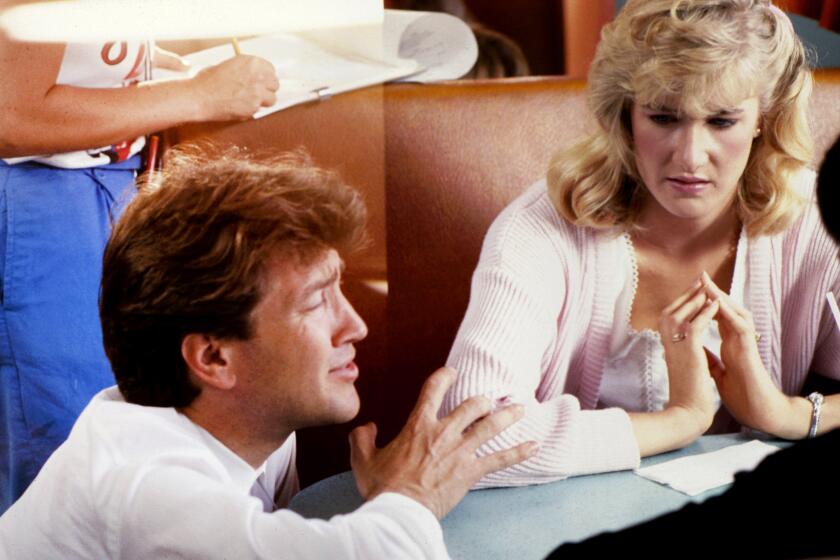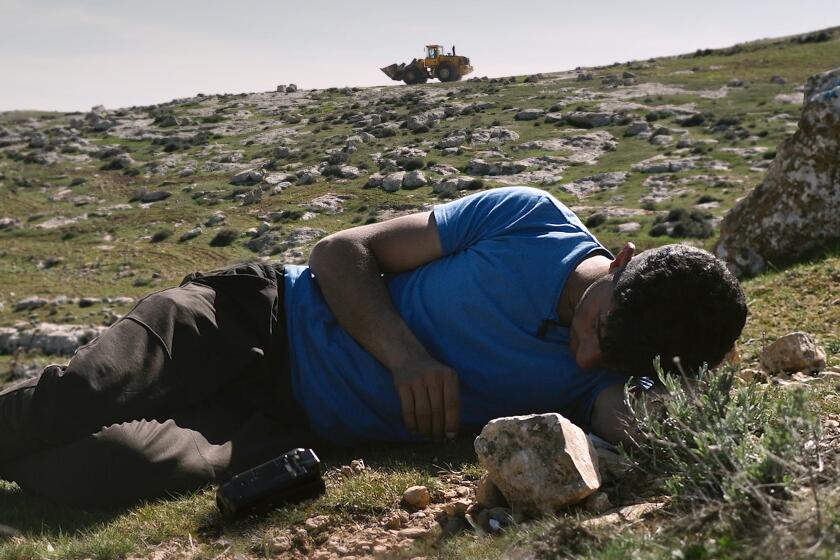No longer ‘dull,’ documentaries rev up art houses
- Share via
Admit it. Until recently, if you had a free Friday night and were forced to pick between going to see a documentary or, let’s say, memorizing the collected speeches of Gov. Gray Davis, you’d probably have said, “What if I just poked myself in the eye with a sharp stick instead?”
But times have changed. For everyone from snobbish cineastes to casual moviegoers, documentaries have gone from a dirty word to de rigueur. When I had lunch with Paramount chief Sherry Lansing the other day, she couldn’t stop raving about her new favorite film -- “Capturing the Friedmans,” Andrew Jarecki’s documentary about a Long Island family embroiled in a sex-crime scandal. At the other end of the Hollywood spectrum, when my preschool recently had a dinner-and-movie fund-raiser, I was asked to suggest a film. Throwing caution to the wind, I chose “Spellbound,” Jeff Blitz’s documentary about the youthful participants in the National Spelling Bee. It was a huge hit.
For the record:
12:00 a.m. July 17, 2003 For The Record
Los Angeles Times Thursday July 17, 2003 Home Edition Main News Part A Page 2 National Desk 0 inches; 20 words Type of Material: Correction
Filmmaker’s name -- Documentary filmmaker Barbara Kopple’s last name was misspelled as Koppel in Tuesday’s Big Picture column in Calendar.
In fact, three of the summer’s four art-house hits are documentaries. “Winged Migration,” a visually arresting film about the flight paths of birds by French filmmaker Jacques Perrin, has made more than $5 million at the box office. “Spellbound” is approaching $4 million, while “Capturing the Friedmans” is nearing the $2-million mark, even in a limited release.
“It’s really kind of a miracle,” says Marc Urman, head of Think Films, which distributes “Spellbound.” “There’s never been a time when so many art-house hits were documentaries, at least not in my lifetime. For a small distributor like us, this is as good as it gets.”
Everyone has gotten into the game. Oliver Stone has been working on a documentary about Fidel Castro. Martin Scorsese, whose documentary portrait of his parents, “Italianamerican,” remains one of his finest films, is making a documentary about Bob Dylan. Coming off the highest-grossing movie in Hollywood history, James Cameron chose to make the documentary “Ghosts of the Abyss.” And naturally, Madonna is at work on a documentary about the kabala. As Cameron told me last year: “People think of documentaries in a very dismissive fashion ... but one of the hardest disciplines I’ve ever had to learn was to be a good documentary filmmaker.”
This comes as no surprise to critics, who’ve known for years that the best film festival movies are found among the documentary entries. What’s so striking about the success of this new wave of documentaries now playing in local theaters is that they’re reaching an audience beyond the chattering class enclaves of Manhattan and Beverly Hills. When Sony Pictures Classics totaled its grosses for “Winged Migration” last week, it found the theaters with the highest grosses were in St. Louis; Portland, Ore.; Sacramento and Minneapolis. Urman says “Spellbound” is racking up impressive numbers at multiplex theaters in Queens, N.Y., and in New Jersey that never before have booked documentaries.
The genre obviously owes a huge debt to Michael Moore, whose “Bowling for Columbine” was a box-office juggernaut, making $21.2 million during a theatrical run that concluded with an Oscar win this spring. Made for $4 million, the documentary out-grossed a host of more costly, star-studded adult-oriented films, including “Far From Heaven,” “Antwone Fisher,” “Adaptation,” “Punch-Drunk Love” and “Confessions of a Dangerous Mind.”
“My 23-year-old son went to see ‘Columbine’ because he loves how irreverent Michael Moore is -- he’s the original ‘Jackass,’ except with a political twist,” says Sheila Nevins, HBO’s executive vice president of original programming who’s made documentaries a hot ticket on the pay TV service. “We used to pursue film distributors. Now they’re calling us. It’s like Lana Turner at the soda fountain -- documentaries have been discovered!”
Nevins deserves a huge dollop of credit for fueling the documentary boom, having made HBO a home for such provocative fare as “Taxicab Confessions,” “Living Dolls,” “Monica in Black and White” and “Southern Comfort.” Nevins, who helped bankroll “The Friedmans” and shares a presentation credit on “Spellbound,” is a sucker for bold storytelling -- her documentary slate has the same must-see sizzle that the New Yorker had with Tina Brown at the helm.
“She’s brought the cash, which one can never make light of,” says Randy Barbato, who with partner Fenton Bailey directed the 2000 documentary “The Eyes of Tammy Faye,” as well as “Monica in Black and White.” “But Sheila also brings this fascinating no-brow, no-apologies attitude. She loves films that have a real emotional punch in the gut, whether it’s about the Holocaust or a Las Vegas bordello.”
In many ways, documentaries have filled a vacuum created by Hollywood, which has severely cut back its output of adult-oriented dramatic films, preferring to woo young moviegoers with visual-effects adventures and comic-book fantasies. “Look at ‘Matrix Reloaded’ and ‘Terminator 3,’ ” Nevins says. “Everything in today’s Hollywood movies is so high-tech and contrived that they’ve lost touch with the stories that get you where it hurts, where you can see people that are like yourself. I mean, when’s the last time you saw a Hollywood movie where someone cries?”
Documentaries also have benefited from a broader embrace of nonfiction storytelling in nearly every cultural arena, be it commercial television, which has been transformed by “reality” TV, or book publishing, which has been buoyed by a string of bestselling memoirs. The cultural currents cut both ways. Innumerable TV shows and feature films have adopted a distinct documentary visual style. As Urmans put it: “Everything from a Dockers commercial to ‘NYPD Blue’ to the [Lars von Trier] Dogma films hailing from Europe is shot to look like CNN.”
But the new documentaries owe a stylistic debt to fiction too. As its title implies, “Spellbound” unfolds like a suspense thriller. “Winged Migration” has the sweep of a David Lean epic. And “Capturing the Friedmans” uses all sorts of novelistic techniques in telling its story. “Stoked: The Rise and Fall of Gator,” a documentary due out next month about the rise and fall of skateboarding icon Mark Rogowski, is cut to the rhythms of ‘80s-era punk bands. “The public’s senses have been tuned up by watching so many hours of sophisticated narrative films that, as a documentarian, you need to give them a complete movie experience,” says Andrew Jarecki, the “Friedmans” director. “There’s no reason not to use a full artistic palette.”
This transformation involves a generational shift. Many of the best documentary filmmakers from the past, including Frederick Wiseman and Barbara Koppel, gravitated toward films about social issues -- or as Nevins puts it, “they wanted to nudge the world.” The new documentarians are more influenced by old movies than high-minded activism. “Spellbound,” for example, was inspired by seeing Rene Clair’s adaptation of Agatha Christie’s suspense classic “And Then There Were None.” “My generation is a lot more comfortable borrowing ideas from older Hollywood films,” “Spellbound’s” Blitz says. “Seeing ‘There Were None’ offered a great lesson in the shorthand of creating characters and building suspense.”
Much of the new energy in documentaries also comes from easy access to cheap equipment. Blitz bought a video camera, practiced for a week and began shooting his film, something he never could have done working with a sophisticated 35-millimeter camera. The new technology encourages a more intimate, informal style of storytelling. When Scott Hamilton Kennedy shot “OT: Our Town,” an upcoming documentary about the first theater production at Dominguez High School in 20 years, he shot the film himself, using a tiny Sony camera that, he says, “looks very much like a model you can buy at Circuit City.”
The camera made him look like an amateur, which softened the kids’ perception of him as an outsider. “Most of the white men who come to Compton are TV newspeople,” Kennedy says. “But because I looked so much less professional, the kids saw me in a new way, not like Channel 11 coming down to report about the cliches of basketball and gangsta rap.”
The new documentaries certainly avoid cliches, in part because they’ve sought out real stories, which provide twists, turns and troubling truths that have been airbrushed out of most of today’s studio films. After Blitz graduated from USC, the young director went out on a round of meetings with Hollywood agents and managers. But it quickly became evident that it might take years before he would have enough clout to direct a feature film.
“I realized that I’d need the approval of so many layers of studio executives, and then have to work with a gigantic film crew. And it got me thinking -- why not find a project I could be completely in control of, where I didn’t have to answer to anyone?” He found his answer in documentaries -- and he found an audience, too.
“The Big Picture” runs every Tuesday in Calendar. If you have questions, ideas or criticism, e-mail them to [email protected].
More to Read
Only good movies
Get the Indie Focus newsletter, Mark Olsen's weekly guide to the world of cinema.
You may occasionally receive promotional content from the Los Angeles Times.










